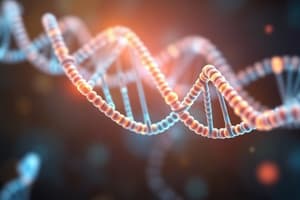Podcast
Questions and Answers
What significant method did Sanger develop for DNA sequencing in 1977?
What significant method did Sanger develop for DNA sequencing in 1977?
- Dideoxy chain-termination (correct)
- Reverse transcription
- Polymerase chain reaction
- Sanger's direct sequencing
Which of the following was not an achievement of Frederick Sanger?
Which of the following was not an achievement of Frederick Sanger?
- Sequencing of the first protein
- Developing a method for insulin production
- Sequencing RNA from E. coli
- Discovery of the double-helix structure (correct)
What was the primary focus of Sanger’s genetic research after winning the Nobel Prize in 1958?
What was the primary focus of Sanger’s genetic research after winning the Nobel Prize in 1958?
- Investigating the structure of RNA and DNA (correct)
- Sequencing human genomes
- Developing vaccines for infectious diseases
- Understanding the structure of carbohydrates
What was one challenge Sanger faced when sequencing DNA compared to RNA?
What was one challenge Sanger faced when sequencing DNA compared to RNA?
Which achievement allowed Sanger's research to contribute significantly to the treatment of diabetes?
Which achievement allowed Sanger's research to contribute significantly to the treatment of diabetes?
What was a significant contribution of Sanger's sequencing method to biotechnology?
What was a significant contribution of Sanger's sequencing method to biotechnology?
Which organism's genome did John Sulston contribute to sequencing in 1988?
Which organism's genome did John Sulston contribute to sequencing in 1988?
What was one of the outcomes of Sanger's sequencing methodology?
What was one of the outcomes of Sanger's sequencing methodology?
In which area did John Sulston receive the Nobel Prize?
In which area did John Sulston receive the Nobel Prize?
What role did John Sulston play in the Human Genome Project?
What role did John Sulston play in the Human Genome Project?
What was the primary focus of Frederick Sanger's doctoral research?
What was the primary focus of Frederick Sanger's doctoral research?
What discovery did Sanger make regarding proteins during his research on insulin?
What discovery did Sanger make regarding proteins during his research on insulin?
Which Nobel Prize did Frederick Sanger receive in 1980, and with whom did he share it?
Which Nobel Prize did Frederick Sanger receive in 1980, and with whom did he share it?
What technique, published in 1977, is named after Frederick Sanger?
What technique, published in 1977, is named after Frederick Sanger?
What was Sanger's role during World War II due to his Quaker beliefs?
What was Sanger's role during World War II due to his Quaker beliefs?
What laboratory technique is associated with Frederick Sanger as a notable contribution?
What laboratory technique is associated with Frederick Sanger as a notable contribution?
Which significant scientific influence did Frederick Sanger experience during his education and career?
Which significant scientific influence did Frederick Sanger experience during his education and career?
Which institution did Frederick Sanger open in 1993, and where is it located?
Which institution did Frederick Sanger open in 1993, and where is it located?
Flashcards are hidden until you start studying
Study Notes
Frederick Sanger and the Sequencing of DNA
- Frederick Sanger was a British biochemist who made significant contributions to molecular biology.
- He was the first person to sequence a protein (insulin) and developed a method for sequencing DNA.
- Sanger won two Nobel Prizes in Chemistry (1958 and 1980) for his work on the chemical structure of proteins and DNA.
- He was awarded his first Nobel Prize for his determination of the amino acid sequence of insulin.
- Sanger's method for DNA sequencing is known as the "Sanger method" or "dideoxy chain termination method."
- He developed a method using radioactive isotopes to label individual fragments and build up the overlapping sequences.
- Sanger’s method enabled scientists to map the first complete human genome in 1981.
- Sanger is considered a pioneer in molecular biology, and his work has had a profound impact on our understanding of life.
John Sulston
- John Sulston is a British biologist who is known for his work on the Human Genome Project.
- He was the first director of the Wellcome Sanger Institute, where he oversaw the sequencing of the Caenorhabditis elegans genome.
- Sulston shared the 2002 Nobel Prize in Physiology or Medicine for his work on programmed cell death.
- He played a key role in the Human Genome Project, which aimed to map all 3 billion base pairs of the human genome.
- His research focused on C. elegans, a nematode worm with a fixed number of cells, making it ideal for studying cell differentiation and programmed cell death.
- His breakthroughs helped to pave the way for understanding how genes control development and how they can go wrong in disease.
Studying That Suits You
Use AI to generate personalized quizzes and flashcards to suit your learning preferences.


